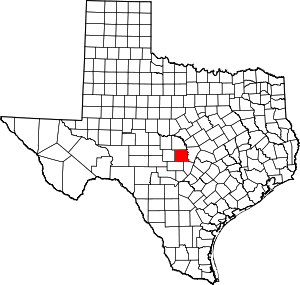Llano, Texas
Llano (/ˈlænoʊ/ LAN-oh) is a city in Llano County, Texas, in the United States. As of 2010, the city population was 3,232. It is the county seat of Llano County.[5]
Llano, Texas | |
|---|---|
 The Llano County Courthouse | |
Location of Llano, Texas | |
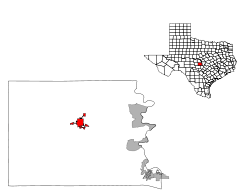 | |
| Coordinates: 30°45′3″N 98°40′48″W | |
| Country | United States |
| State | Texas |
| County | Llano |
| Area | |
| • Total | 5.59 sq mi (14.48 km2) |
| • Land | 5.27 sq mi (13.65 km2) |
| • Water | 0.32 sq mi (0.83 km2) |
| Elevation | 1,030 ft (314 m) |
| Population (2010) | |
| • Total | 3,232 |
| • Estimate (2019)[2] | 3,497 |
| • Density | 663.69/sq mi (256.27/km2) |
| Demonym(s) | Llanite |
| Time zone | UTC-6 (Central (CST)) |
| • Summer (DST) | UTC-5 (CDT) |
| ZIP code | 78643 |
| Area code(s) | 325 |
| FIPS code | 48-43144[3] |
| GNIS feature ID | 1361576[4] |
| Website | http://www.cityofllano.com/ |
Geography
Llano is located at 30°45′03″N 98°40′48″W (30.750953, −98.680038).[6] It is on the Llano River, 65 miles (105 km) northwest of Austin and 102 mi (164 km) north of San Antonio.
According to the United States Census Bureau, the city has a total area of 4.7 sq mi (12 km2), of which, 4.4 sq mi (11 km2) of it is land and 0.3 sq mi (0.78 km2) of it (5.53%) is covered by water.
Demographics
As of the census[3] of 2000, 3,325 people, 1,353 households, and 880 families resided in the city. The population density was 748.1 people per square mile (289.1/km2). The 1,539 housing units averaged 346.3/sq mi (133.8/km2) in density. The racial makeup of the city was 94.35% White, 0.57% African American, 0.66% Native American, 0.24% Asian, 3.40% from other races, and 0.78% from two or more races. Hispanics or Latinos of any race were 8.90% of the population.
Of the 1,353 households, 28.8% had children under the age of 18 living with them, 48.6% were married couples living together, 12.9% had a female householder with no husband present, and 34.9% were not families. About 31.3% of all households were made up of individuals, and 18.2% had someone living alone who was 65 years of age or older. The average household size was 2.35 and the average family size was 2.95.
In the city, the population was distributed as 24.5% under the age of 18, 7.2% from 18 to 24, 23.9% from 25 to 44, 22.4% from 45 to 64, and 22.0% who were 65 years of age or older. The median age was 41 years. For every 100 females, there were 89.9 males. For every 100 females age 18 and over, there were 83.1 males.
The median income for a household in the city was $31,706, and for a family was $38,125. Males had a median income of $29,464 versus $19,958 for females. The per capita income for the city was $16,306. About 7.7% of families and 10.2% of the population were below the poverty line, including 13.8% of those under age 18 and 2.6% of those age 65 or over.
Climate
Llano experiences a humid subtropical climate, with hot summers and generally mild winters. Temperatures range from 84 °F (29 °C) in the summer to 46 °F (7.8 °C) during winter.
| Climate data for Llano, Texas | |||||||||||||
|---|---|---|---|---|---|---|---|---|---|---|---|---|---|
| Month | Jan | Feb | Mar | Apr | May | Jun | Jul | Aug | Sep | Oct | Nov | Dec | Year |
| Record high °F (°C) | 93 (34) |
100 (38) |
100 (38) |
105 (41) |
108 (42) |
112 (44) |
115 (46) |
113 (45) |
112 (44) |
105 (41) |
94 (34) |
93 (34) |
115 (46) |
| Average high °F (°C) | 60 (16) |
64 (18) |
72 (22) |
79 (26) |
85 (29) |
91 (33) |
96 (36) |
96 (36) |
90 (32) |
81 (27) |
69 (21) |
61 (16) |
79 (26) |
| Daily mean °F (°C) | 46 (8) |
50 (10) |
58 (14) |
65 (18) |
73 (23) |
80 (27) |
84 (29) |
83 (28) |
77 (25) |
67 (19) |
56 (13) |
48 (9) |
66 (19) |
| Average low °F (°C) | 32 (0) |
36 (2) |
44 (7) |
52 (11) |
62 (17) |
69 (21) |
71 (22) |
70 (21) |
64 (18) |
54 (12) |
43 (6) |
34 (1) |
53 (12) |
| Record low °F (°C) | −6 (−21) |
−3 (−19) |
14 (−10) |
25 (−4) |
28 (−2) |
38 (3) |
50 (10) |
46 (8) |
35 (2) |
23 (−5) |
15 (−9) |
−7 (−22) |
−7 (−22) |
| Average precipitation inches (mm) | 1.08 (27) |
1.80 (46) |
1.90 (48) |
2.19 (56) |
3.94 (100) |
3.40 (86) |
1.84 (47) |
2.03 (52) |
2.14 (54) |
2.88 (73) |
2.23 (57) |
1.90 (48) |
27.33 (694) |
| Source: The Weather Channel [8] | |||||||||||||
History
.jpg)
.jpg)
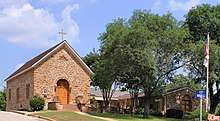

Llano County was established in compliance with a February 1, 1856, state legislative act. The Llano River location was chosen in an election held on June 14, 1856, under a live oak on the south bank of the river, near the present site of Roy Inks Bridge in Llano. Into the 1870s, the town was little more than a frontier trading center, with a few log buildings housing business establishments, a post office, and a few homes. In 1879, the first bank, Moore, Foster, and Company, was founded, and during the 1880s, Llano acquired a number of new enterprises that served the county's farmers and ranchers. After the county outgrew the one-story stone building that had housed its public offices, in 1885, an ornate brick courthouse was completed on the square on the south side of the river. A fire on January 22, 1892, destroyed this courthouse; the present county courthouse was completed and occupied on August 1, 1893. It is listed in the National Register of Historic Places.
In the 1880s the Llano Rural, the town's first newspaper, was established, followed by the Iron City News, the name of which reflects growing interest in the county's mineral resources. The Rural eventually incorporated several other newspapers, including the Advocate, the Searchlight, and the Gazette, to become the Llano News by the early 1900s. The Llano Times was where J. Marvin Hunter, author and historian of the American West, worked on the staff for a brief time early in the 20th century.[9]
Anticipation of significant economic growth based on the iron deposits discovered at Iron Mountain in northwestern Llano County attracted capital from Dallas and from northern states, and the boom years of Llano-from 1886 to 1893-were launched. The Llano Improvement and Furnace Company undertook plans for an iron furnace and foundry, as well as for the development of commercial real estate, on the hitherto undeveloped north side of the river. Charters were undertaken for a dam, an electric power plant, a streetcar system, and electric street lights, while expectations of growth were high. Steel-town names such as Birmingham, Pittsburgh, and Bessemer were chosen for streets on the north side; Llano was to be the "Pittsburgh of the West", but only a small dam and the street lighting were completed. By one report, the population reached 7,000 in 1890. In 1892, at the peak of the boom period, the town was incorporated, the river was bridged, and the Austin and Northwestern Railroad was extended to a terminal on the north side of Llano. Because of the improved transportation, several granite cutting and finishing businesses moved to town in this period. Many of the new businesses were begun in the boom period, and substantial brick establishments were constructed around the public square on the north side of the river. Among these, the Algona Hotel became a focal point for the town's new social life. It was damaged by a cyclone in 1900 and burned to the ground in 1923. Because the county's mineral resources, with the significant exception of granite, did not exist in commercially exploitable concentrations, the boom period soon faded. Plans to connect Llano with Fredericksburg via an extension of the San Antonio and Aransas Pass Railway were not fulfilled. A series of fires in the early 1890s, probably set to collect insurance on unprofitable properties, destroyed many of the new business establishments. Such fires were so numerous, fire insurance was denied to the town for several years.
Farming, ranching, and the granite industry remained the foundations of the town's economy in the 20th century. In the 1920s, Llano was a major shipping point for cattle; the cotton industry flourished in the county through the 1930s, but declined thereafter into insignificance. Granite quarrying and finishing retained their importance, amounting to a million-dollar-a-year industry by the 1950s. The Roy Inks Bridge, named for a former mayor, was built after a flood crest of 42 feet in 1935 swept away the 1892 structure. By 1964, the town had a new hospital, a post office, school buildings, a community center, a rodeo area, and a golf course, along with a city park and improved water system. Llano was an important link in the Highland Lakes chain of tourist areas, and attracted many hunters during the deer season. A winery, feed processing, and insecticide and commercial talc production represented new industry. Actress Sophia Loren, friend and correspondent of Netherlands native Anthony Goossens, priest of Holy Trinity Catholic Church in Llano, contributed to the church fund-raising campaign in 1975. By 1983, the National Register of Historic Places listed, in addition to the courthouse, the Llano jail, the Southern Hotel, and the Badu Building, former bank and home of French immigrant and mineralogist N. J. Badu, now a bed-and-breakfast establishment.[10]
2018 flood
In October 2018, Llano experienced heavy rainfall and flooding following Hurricane Sergio.[11] Rainfall in Llano exceeded 9.8 inches (250 mm) and the sea level of Llano River rose about 25 feet (7.6 m) in 12 hours.[12] The body of an unidentified woman was found on the banks alongside the Colorado River following the flooding in Llano.[13]
Registered historical places
Badu Building
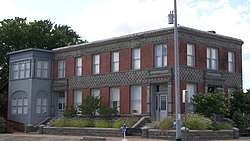
Llano County Courthouse and Red Top Jail
Southern Hotel

Llano County Museum
The Llano County Museum is located in the former Bruhl's Drugstore owned by German native Louis Herman Bruhl (1849–1931). Bruhl married the former Leonie Julia Hammale, a merchant and pharmacist. They first lived in Waco and Rockport. Bruhl was U.S. consul to Italy from 1894–1899 and then opened the drugstore in Llano. Their son, Lawrence Lee Bruhl (1905–1999), was a Llano attorney.[14]
The museum, located on the north end of the Llano River bridge, has exhibits on local history, including a chuckwagon, drug store artifacts, and an outdoor frontier cabin. Also, it has a collection on 1930s world polo player and Llano native Cecil Smith[14] (February 14, 1904—January 21, 1999), later of Kendall County.[15]
Adjacent to the museum is the Historic Railyard District in which a train depot hosts a railroad museum and visitor's center.[16]
Education
The City of Llano is served by the Llano Independent School District, which includes Packsaddle Elementary, Llano Elementary, Llano Junior High, and Llano High School. Llano's mascot is the Yellow Jacket and the school colors are orange and black. The Llano Independent School District serves about 1,900 students and is currently a part of District-13AAAA, also including Wimberly, Austin Eastside Memorial, Bandera, Cuero, and Navarro.
Events
- @LAST Llano Art Studio Tour - last Saturday in March
- - march 15-18th 2019 LAND ART
- Bluebonnet Trail Art & Craft Show - first & second weekends in April
- Llano Artwalk April 23https://www.facebook.com/llanoartwalk/
Llano Crawfish Open - third weekend in April
- Llano County Rodeo and Parade - first weekend in June
- Llano Trail of the Deer Community Art Project
- Rock'n Riverfest - July 4 weekend
- Chuck Wagon Cook-Off - third Saturday in October
- Heritage Day - third Saturday in October
- Christmas in the Park, Lighted Christmas Parade, Santa's Big Night, Lighting of the Llano County Courthouse - after Thanksgiving
- Llano Earth Art Fest, home of the World Rockstacking Championship - second weekend of March
Recreation
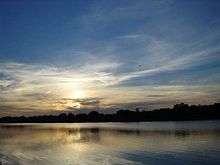
.jpg)
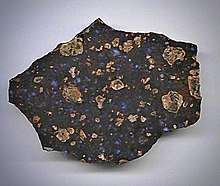
Hunting
Llano is widely known as the Deer Capital of Texas. The density of deer in the Llano Basin is the highest in the nation. Hunters from all over come to Llano for deer, quail, dove, feral pig, and turkey hunting, using guns as well as bow hunting.
Fishing
The spring-fed Llano River, which runs through the city, offers some of the best fishing in the area, and has become well known to fly anglers throughout Texas. The eastern border of Llano County features three of the Texas Highland Lakes, including Lake Buchanan, Inks Lake, and Lake LBJ. Today, white bass, striped bass, largemouth bass, catfish, spotted bass, crappie, and Guadalupe bass attract fisherman to these lakes year round.
Birding
The bald eagle makes its home in Llano County during its annual winter migration. Nine miles (14 km) east of Llano on Highway 29, a family of bald eagles can be viewed from the roadside during the nesting season.[17]
Golf
The Llano River Golf Course is located two miles (3 km) west of the Llano Courthouse on the Ranch Road 152, adjacent to Robinson City Park. The 18-hole golf is located on the banks of the Llano River. A fully equipped pro shop and golf carts are also available.[18]
Geology and archaeology
Llanite, a rare type of brown rhyolite porphyry with sky-blue quartz crystals and rusty-pink microcline feldspar, is found nowhere else in the world except in Llano County. Llanite can be found along a highway cut 9 mi (14 km) north of Llano on Texas 16. The largest piece of polished llanite in the world can be seen at the Badu House.
The centuries-long habitation of various Native American tribes in the area has produced numerous archaeological sites which attract amateur archaeologists year-round.
An extensive exhibit of artifacts, both Native American and early Texan, and a large display of area gems and minerals are on permanent exhibition at the Llano County Museum.[19]
Notable people
- W. C. Jameson, author, treasurer hunter, musician, singer, songwriter, actor, is a resident of Llano
See also
| Wikivoyage has a travel guide for Llano. |
References
- "2019 U.S. Gazetteer Files". United States Census Bureau. Retrieved August 7, 2020.
- "Population and Housing Unit Estimates". United States Census Bureau. May 24, 2020. Retrieved May 27, 2020.
- "U.S. Census website". United States Census Bureau. Retrieved January 31, 2008.
- "US Board on Geographic Names". United States Geological Survey. October 25, 2007. Retrieved January 31, 2008.
- "Find a County". National Association of Counties. Retrieved June 7, 2011.
- "US Gazetteer files: 2010, 2000, and 1990". United States Census Bureau. February 12, 2011. Retrieved April 23, 2011.
- "Census of Population and Housing". Census.gov. Retrieved June 4, 2015.
- "Monthly Averages for Llano, Texas". The Weather Channel. August 2011. Archived from the original on October 23, 2012.
- Gard, Wayne. "John Marvin Hunter". Handbook of Texas Online. Texas State Historical Association. Retrieved December 12, 2010.
- Heckert-Greene, James B. "Llano, Texas". Handbook of Texas Online. Texas State Historical Association. Retrieved December 12, 2010.
- Teo Blašković, Don (October 17, 2018). "Deadly floods hit Texas after extreme rainfall, state of emergency declared". The Watchers. Retrieved November 29, 2018.
- Caroline Floyd (October 16, 2018). "Stunning video shows bridge washed away in Texas flood". The Weather Network. Retrieved October 20, 2018.
- "Texas Flooding Kills 2; Bus Driver Arrested for Endangering a Child". The Weather Channel. October 17, 2018. Retrieved October 20, 2018.
- "Llano County Historical Museum". Retrieved December 12, 2010.
- "Social Security Death Index". Rootsweb.ancestry.com. Archived from the original on March 12, 2009. Retrieved July 7, 2009.
- "A Treasure Hunter's Paradise in Llano's Historic Railyard District". Hill Country Current. June 2010. Archived from the original on October 30, 2013.
- | Attractions | Llano Chamber of Commerce
- | Recreation | Llano Chamber of Commerce
- | Heritage | Llano Chamber of Commerce
External links
| Wikimedia Commons has media related to Llano, Texas. |
